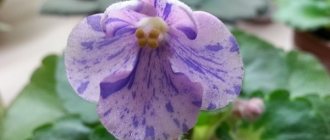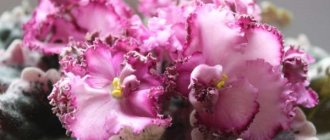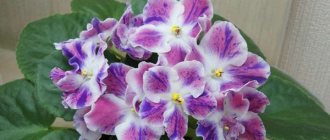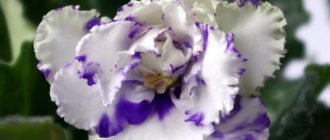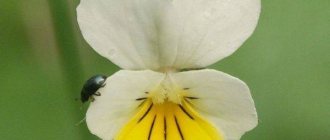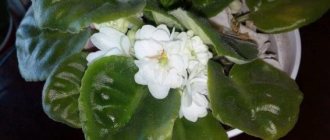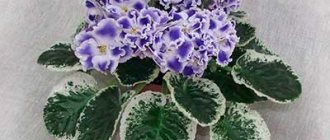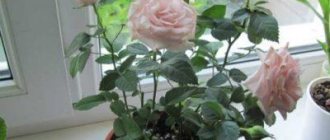The magnificent variety Grog was given to the world by the famous foreign Saintpaulia collector Hortense Pittman. Pittman was born in Texas.
She was given her first violet for her birthday, and thus began a lifelong love story for violets.
In 1979, Hortensia registered her first variety, and in 1995 she became an honorary and lifelong member of the AVSA, and now, even when the famous breeder has passed away, her name is included in the AVSA Gallery of Fame for her recognized services.
Violet Ma's Melody Girl (O. Robinson), or Melodious Girl
Photo and description of the variety
This variety is a registered sport from Ode to Beaty (G.Cox/B.Johnson).
Violet Ode to Beaty.
Standard rosette, quilted gel foliage , round and scalloped leaf plate. The rosette is small, round and neat, from the outside it resembles a ball. If the violet does not receive enough light, it begins to lift its leaves up and this slightly spoils its decorative qualities.
The center of the leaf blade is lighter than the edges.
Photo of violet Mas Melody Girl.
There are two lines of this variety - with darker and lighter foliage . But in any case, the edges of the leaf plate are always darker and shiny.
The line of the variety that has dark foliage is distinguished by a flatter rosette. Areas of leaf blades that should be yellow-green take on a slight reddish tint.
Despite the fact that the author's description indicates a standard, the violet can rather be classified as a small standard . It reaches a size of 12 to 18 cm.
The bush is very beautiful and even between flowering periods does not lose its attractiveness.
The flower is a semi-double coral star with a clear white edge and thick fantasy patches of crimson.
Fantasy inclusions have the shape of small dots that are located closer to the edge of the petals.
The flowers are very bright and beautiful. The crimson dots along the pink petal closer to the edge turn into a border, and a thin border with clear boundaries refreshes and makes the flower more delicate and touching.
The diameter of the bud in full bloom reaches 2-4 cm. The peduncles are even, strong, and erect. About five buds can form on each of them.
Always blooms in bouquets, flower stalks do not lie on the foliage. from three to five weeks in dissolution
Don't expect a lush bouquet from the first flowering. But every time the flowers become larger and more magnificent.
Also, with age, color saturation increases.
It is worth noting that this variety is very original, does not require a large area, and is very compact.
Also, the violet is in no hurry to bloom and can produce its first bloom 12-14 months after planting the baby. But even during the first flowering it will not produce a cap of flowers.
The variety is capricious, not for beginners. There are some difficulties in care.
It propagates well by leaf cuttings, takes root easily, and produces many children.
Prefers plenty of light , and at the slightest lack of light it begins to lift its leaves. Should be grown on a windowsill in natural light.
It cannot be said that it will stretch out on the racks, but it will not flower in such conditions.
It is worth placing on the brightest windowsill. In this case, the outlet will be very smooth and compact.
Very high tendency to form stepchildren . It is necessary to carefully monitor the number of growth points and remove all unnecessary ones in a timely manner.
The scalloped gel foliage is very dense and if the development of lateral stepsons is allowed, the rosette will become overgrown.
Attention! During short daylight hours, development and flowering stops.
Violet Balchug Stay
Dear violet Balchug Stay.
The pastel variety has been found in collections since 2010 .
Description of the variety
Saintpaulia itself forms even bushes with perfect symmetry and a fairly high degree of fullness. The leaves on elongated petioles are slightly tucked down, forming a voluminous hemispherical rosette. According to the numerical gradation of dimensions, the variety falls into semi-miniature varieties.
Oval leaves differ:
- A clearly visible emerald veining pattern;
- Quilted surface;
- Small, smoothly rounded edge teeth;
- And the tonality of dark green.
The variety has a bed shade of flowers.
The bush blooms with a cap of simple flowers, painted in pastel shades of pink with coral splashes. Darker markings are visible at the base of the petals. The edges of each petal are decorated with elegant frilly braid.
Sports
After several flowerings it can develop into abundant fringe and a more coral tone.
Sport violets in a coral shade.
Peculiarities
Saintpaulia is rarely found in collections, although it shows such positive qualities as:
- Ideal outlines;
- Growing up fast;
- Abundance of buds.
The violet is growing quickly.
The variety does not like to form many children. Flowers acquire a reddish hue as they age.
Reviews
Ilya Ilyich. “I respect the selection of I. Milekhin - magnificent miniatures for every taste. In the Balchugov line, I especially highlight “B. Stay" for the delicate tones and long-lasting flowers."
Caring for a plant at home
Ma's Melody Girl violet should be placed on the brightest windowsill. This variety is sensitive to light. If there is not enough of it, the plant stops growing and does not produce flower stalks.
Proper watering and fertilizing
The plant can be kept on a wick, but top watering or watering in a tray is also allowed.
The water must be purified or settled.
The frequency of watering depends on air temperature and weather conditions . You can add water only when the top layer of the earthen clod becomes dry.
Fertilizing is applied according to the standard scheme , but it is worth limiting the nitrogen content. It is this substance that can provoke excessive formation of lateral stepsons.
Lighting and temperature
The Ma's Melody Girl variety is very demanding in terms of lighting. This plant will feel best on a windowsill. The lamp and rack are not suitable for this violet. It won't die, but it won't bloom.
The air temperature should be between +18 and + 22°C . The plant will be able to survive in more difficult temperature conditions, but will lose its flowering appearance.
Do not place the plant in drafts or allow sudden changes in temperature. This is fraught with the development of diseases and even the death of the outlet.
Air humidity
This figure should fluctuate between 50-60%. Very high humidity will lead to fungal diseases.
Optimal air humidity is 50-60%.
Important! Too dry air also has a detrimental effect on the condition of the plant. Leaf plates may curl and lose their decorative effect.
Soil composition
For this violet it is worth using soil mixtures of medium nutritional value. The soil should have good air permeability and also retain moisture. The Saintpaulia root system should be moist. Overdrying and excessive humidity can lead to the development of diseases or even death of the plant.
You can use standard or special mixtures or make your own. The soil should not contain clay.
You should mix sand, peat, leaf and turf soil, and sand. Vermiculite, agroperlite, pieces of sphagnum moss and crushed coal are also used as additional components.
Pruning and hygiene
Ma's Melody Girl violet is prone to excessive lateral growth points. It should be removed promptly. If they grow, the rosette will lose its decorative appearance and stop producing flower stalks.
Reproduction methods
The variety is propagated by cuttings.
It takes root easily, produces many children, and is not prone to genetic mutations.
also root lateral stepsons.
Such specimens will grow much faster.
Rules for transplantation and rejuvenation
Transplantation occurs once a year . It is best to do this at the end of February. The plant is carefully dumped out of the pot, excess soil is shaken off, and if necessary, all diseased and rotten parts of the plant are removed.
All cuts should be sprinkled with crushed coal.
After the procedure, the violet is transplanted into a new container and fertilizers are forgotten for two months.
If necessary, if the trunk of the plant is too high, then the top of the plant is cut off and placed on rooting for rejuvenation . Young roots should appear in two to three weeks.
Rooting the top in water.
Difficulties in growing
If you follow the basic rules of agricultural cultivation and care standards, the described plant does not cause difficulties. Due to inaccuracies in observing these principles and rules, Aphrodite's immunity to various infections sharply decreases, thereby creating favorable conditions for the appearance of pests.
The main diseases and pests of Aphrodite violet, as well as methods of treating them:
| Symptoms | The main reason | Remedies |
| Putrefactive lesions of foliage and stems | Late blight | The number of waterings is reduced, the flower is treated with a solution of “Fitosporin” (1 g/5 l of water), and then planted in a new pot with clean soil |
| Root rotting | Root (fungal) rot | The flower must be treated with a solution of the drug “Topaz” (1.5 ml/1 water), and then trimmed and transplanted into a new substrate |
| White coating on foliage | Powdery mildew | The plant is treated with a solution of the drug “Fitosporin” (1g/5l of water) |
| Withering, curling of leaves, sometimes accompanied by a slight matte coating | The appearance of aphids, spider mites | Double treatment with Actellik (1 ml/l of water) |
Violet Aphrodite amazes many gardeners and lovers of these plants with the beauty of its unique double flowers. You can get a healthy and flowering bush if you follow all the rules for caring for and maintaining violets described above.
Features of growth, flowering and reproduction
The violet develops rather slowly. To grow a full-fledged rosette and get bouquet flowering, you need to be patient. As a rule, this requires at least a year.
reproduces well , takes root well, and has no tendency to genetic mutations.
Prefers cool weather ; in hot weather, the flowering period is significantly reduced.
The peduncles are tall, straight, strong , and hold buds well. Each of them can have up to five flowers.
Ma's Melody Girl's flower stalks are very strong.
The first flowering is modest , but with each subsequent bloom the bouquet becomes more lush and bright. One bud blooms for about three weeks.
Reviews
Olga, Samara. “The variety is very elegant. But if it starts to turn very white, it can grow a large number of whitish leaves and die from this. That's why I always have a couple of copies growing. I really like this excellent variegation.”
Leonid. “The variety grows without any complaints, the main thing is to remove the stepsons in time, then it will bloom continuously. Growing on a shelf. On the very bottom shelf, the variety is a very beautiful favorite in my collection.”
How to propagate at home
The variety is propagated vegetatively: by leaf cuttings or so-called baby. You can purchase planting material in online stores for gardeners.
Cuttings
As a cutting, take a leaf that is elastic and healthy, preferably from the middle row of the rosette.
Sequencing:
- The cuttings are cut at an angle of 40–45°.
- Place it in a container (plastic cup) with water, stirring a charcoal tablet in it.
- Cover the container with a greenhouse.
- After the roots appear, they are transplanted into a pot with soil.
Video: propagation of violets by cuttings
Children
Babies can be grown from a rooted leaf. The approximate period of appearance is 2–6 months.
Technology:
- The young bush is carefully dumped out of the container.
- Separate the baby with its own root system and at least two leaves.
- Transplant into a small pot up to 5–6 cm high.
Video: propagation of violets by children
History of development
Violet Optimara: photo of the variety
The Optimara violet has captivated flower growers with its beauty for quite a number of years. The year the plant was founded was one thousand nine hundred and eighty-nine, this year became the year of breeding the plant of different colors, since before that the plant only had lilac buds. After it became clear what could be done with the color, experts began to determine the size of the buds. There were many options from small to large plant sizes. Such processes could not be hidden. Then the breeders above learned about this and entered a new stage in the development of violets.
Most flower growers began to notice that the Optimara violet variety has appeared on display windows in stores or greenhouses. This is not some special variety of violet, it’s just that this flower is grown in a company called Optimara. The buds of this plant are tropical; they can bloom once. Violets of this variety do not tolerate cold weather, this can affect the development of the inflorescence and also damage the roots, which so need constant warmth. Thus, beautiful flowers from Africa take a short time to develop, and they are also impossible to plant.
To make the flower live a little longer, it is developed by cuttings.
You can purchase the plant as a bouquet, which is sold in pots. The inflorescence occurs once; further care for the plant is not required. Such plants grow and bloom at the same time. Its advantage is the beauty of the inflorescences. Optimara violets are used in industry, so they can be easily transported and no plants will be harmed.
The highlight of the Optimara violet variety is the large number of inflorescences of different colors, which is why it is so relevant in sales today. The birth of such a brand began in nineteen thirty, this happened in Germany, when M. Dorrenbach began to grow violet seeds of this variety. this breeder made it possible to grow his business on this plant and achieved his goals. He was also helped in development by his son Reinhlt, who also worked on the business and raised it to such an extent that their company became known throughout the world. As soon as they began to grow plants, this happened in small greenhouses, then, with growing success in business, all the plants were overgrown with Uzambara Saintpaulia.
The goal of this company, Optimara, is to create a large number of different plant species. At the moment, there is already a huge number of different varieties on the company’s website, some of which have not even come up with a name yet. Therefore, new plants began to be given numbers, but the name of the discoverer must be written. Manufacturers do not produce the same variety; variety is important to them, which is what they are working on.
Systematic position
Both variations of violets are included in the powerfully variable Saintpaulia genus, enchanting with its heterogeneity of artistic outlines, included in the Gesneriev family.
Recommended varieties of violets according to the category of green mass size are included in the miniature and semi-miniature format segment , also relating, according to the structure of the distribution of the number of petals in their flowers , to the module of simple or, very rarely, semi-double Saintpaulias.
Creator of varieties
The two described varieties, stunningly enlivening any home collection, were registered in the lists of AVSA , the main American society of violet growers.
This was done by an active popularizer of Saintpaulia and a wonderful Texas breeder, whose name is in the AVSA Hall of Fame, Hortense Pittman at the final stage of the next seasons of work in the field of breeding exotic beauties.
Hortense Pittman's penchant for growing violets began around the mid-twentieth century (late 60s) thanks to a single specimen of Saintpaulia given to her as a gift.
1979 was marked by the appearance of her own varietal specimen, and then more than 670 different varieties were created from several proprietary lines.
are especially loved by the master .
IMPORTANT! The violets presented are examples from the most significant line of G. Pittman with the abbreviation “Jolly”.
